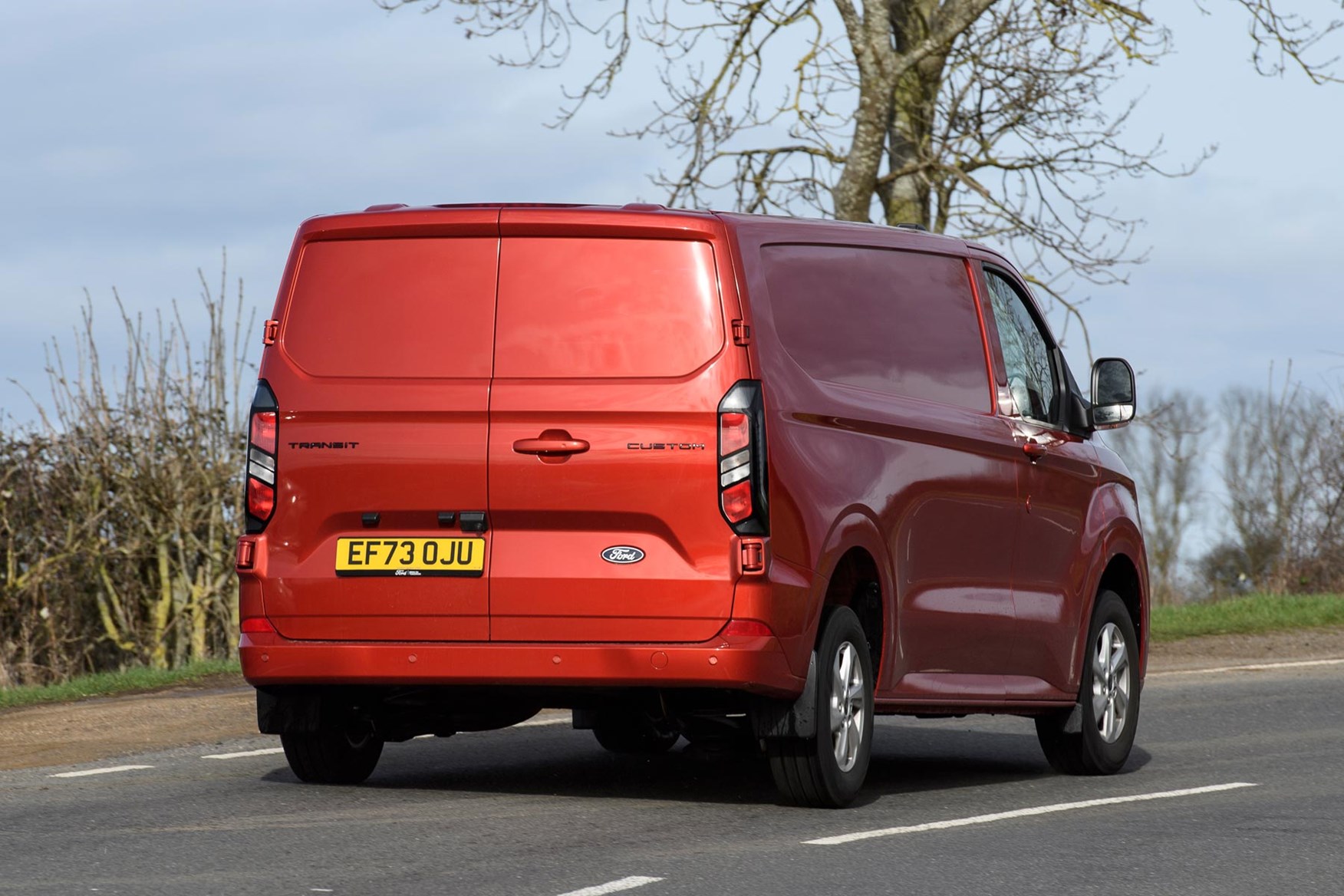Ford Transit Custom van review (2024)
The UK's favourite van gets even better
PROS
- Lots of clever thoughtful touches
- Flat cabin floor
- Wide range of engines and styles
- Car like to drive
- Strong payload potential
CONS
- Noisy diesel engines
- Low roof makes for cramped feeling cabin
- No overhead storage
- Over-light steering
- Staggered arrival for different versions
Summary
Does the Ford Transit Custom really need much of an introduction? You will likely see one every time you head out on the road and for many people it is the default and best medium van. It has historically set the standard by which all of its rivals are judged.
It has also led all others in terms of sales, consistently finishing top of the overall annual charts – not just for vans but it is the most popular vehicle in the UK full stop.
This means the 2024 model starts from a privileged position, but also one with a degree of pressure – there is a lot of goodwill behind the Transit Custom but it also needs to live up to some fantastically high standards.
While Ford is retaining some core elements of the tried and tested predecessor, this new version takes some decisive and determined strides forward. Some of these provide genuine innovation with some small touches that are designed to appeal to the workers up and down the country that spend every day in their van.
What versions of the Ford Transit Custom are there at launch?
Although Ford has a wide array of versions of Transit Custom planned, not all of these will be available at launch. To start off with you get some familiar diesel engines – the 2.0-litre units that powered the previous generation with a choice of 110, 136, 150 and 170hp power outputs.
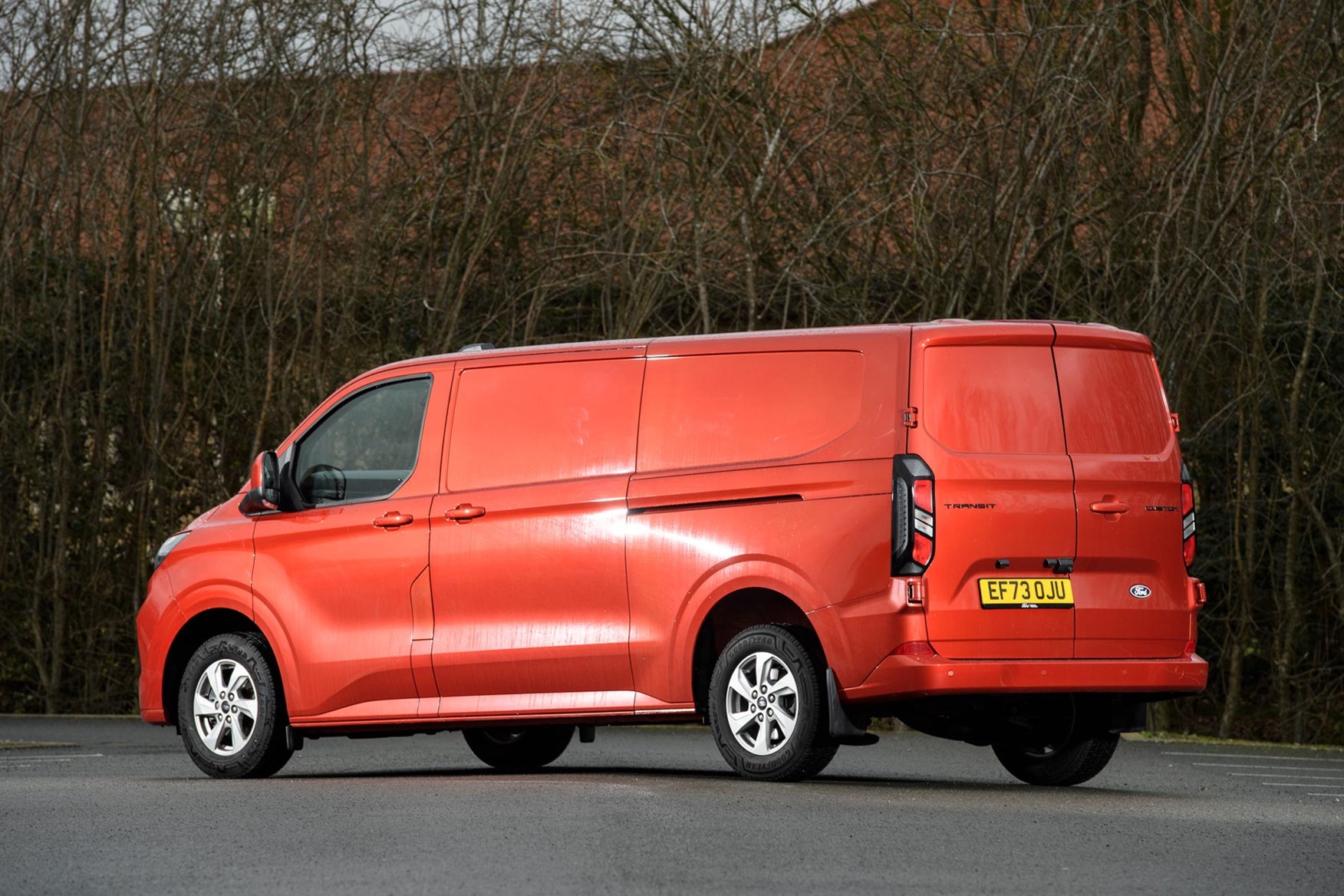
There is, however, one notably different engine at launch – a plug-in hybrid. This promises to be a big step removed from the previous Transit Custom PHEV, with this new version combining a 2.5-litre petrol engine and a 65kWh battery. This is the same engine that sits in the Ford Kuga SUV. The previous version was more of a range extender, with a small 1.0-litre petrol engine, which this would appear to be much closer to the plug-in hybrids that have proved popular in the car world.
The future holds more, though, with the all-electric version due in April 2024. This will be joined by several promising sounding different body styles. A higher version, a double-cab-in-van model, a Kombi and an innovative sounding Multicab model will all join the range. The latter of these employs an L-shaped bulkhead to provide seating for up to five and a narrow section of full-length loading bay – a best of both worlds approach.
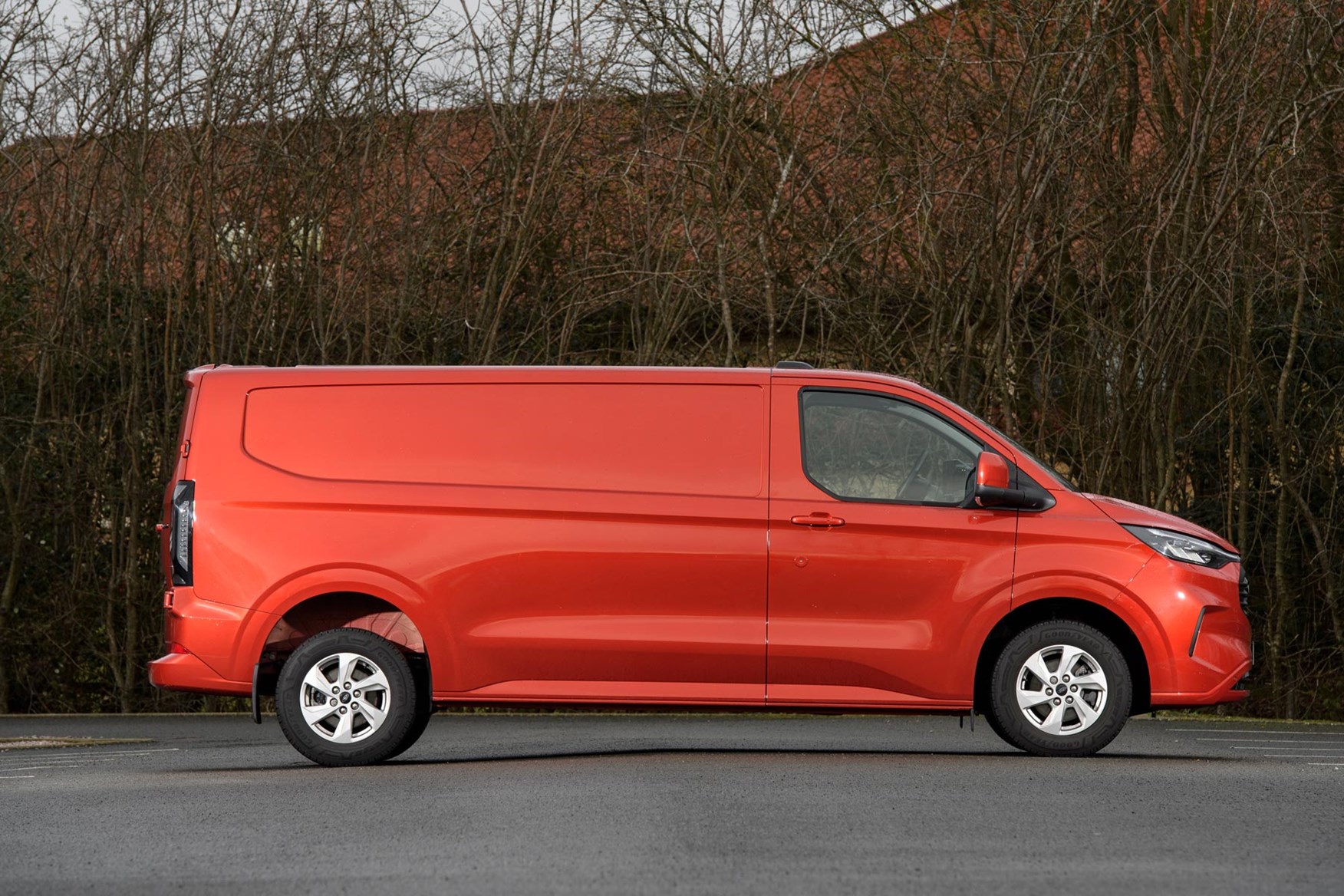
There is also the passenger-focused Ford Tourneo Custom, which has moved higher upmarket and is targeting the luxury people-moving market.
What are the Ford Transit Custom’s rivals?
What aren’t the Custom’s rivals? Every mid-size van wants to take on the Ford Transit Custom, and every major manufacturer has a contender in the market.
Plenty of them are rather samey, with the Stellantis group of vans taking a simplistic approach. The Citroen Dispatch, Peugeot Expert, Fiat Scudo and Vauxhall Vivaro are all the same van with different badges on them. You can add the Toyota Proace to this list too – although Toyota isn’t part of the Stellantis group, it takes the same approach of rebadging the medium-sized van.
The Renault Trafic and Nissan Primastar take the same approach, as both are fundamentally the same vehicle. They are a rarity in that they offer more than one height, and the electric version of the Trafic adds a welcome extra option in the class.
Historically the Volkswagen Transporter has been one of the Ford’s biggest rivals, but the two brands have paired up to develop their new medium van, so the next generation of VW will be a Transit Custom in many ways. We have yet to see the new vehicle, but expect it to share a lot of the major fundamentals from the Ford. The VW ID.Buzz Cargo might well be on the same shopping list as the Ford E-Transit Custom, too.
The Mercedes-Benz Vito adds a touch of premium badge class to the sector.
Verdict: is the Ford Transit Custom any good?
In short, the best has got better. This is more than just a revamping of the same formula, though, as there are several core features that stand out as being genuinely different to the predecessor. These range from small little user-friendly details such as a loading bay that is easier to get into, up to an innovative flat floor that makes the cabin a more practical place to be.
Ford has retained plenty of the Transit Custom’s enduringly popular character, though, so it certainly won’t scare off those who have covered thousands of miles in previous versions. It should deservedly retain its position as the UK’s favourite van.
Skip to our full verdict on...
- More car like than ever
- Great visibility
- Light steering
Ford has made notable changes to how the Transit Custom drives, and it may or may not be to your taste. In short, it has made it more car-like to drive, which could be a good thing, or could take something away from the overall experience.
The Ford Transit Custom on the road
The main change is to the steering. Ford has made everything feel lighter, so it takes less effort to turn the wheel and therefore makes the Transit Custom almost feel fractionally smaller and, dare we say it, more car like.
This is good in some senses, as plenty of drivers get into a van from their car and want to feel like it is as accessible as possible. Making it feel simple and easy to get around town, and that you don’t need to make decisive movements all adds to the impression that this isn’t a huge and intimidating vehicle. It means you don’t need to do much to move between lanes at higher speeds, either, although it stops short of feeling twitchy in this situation.
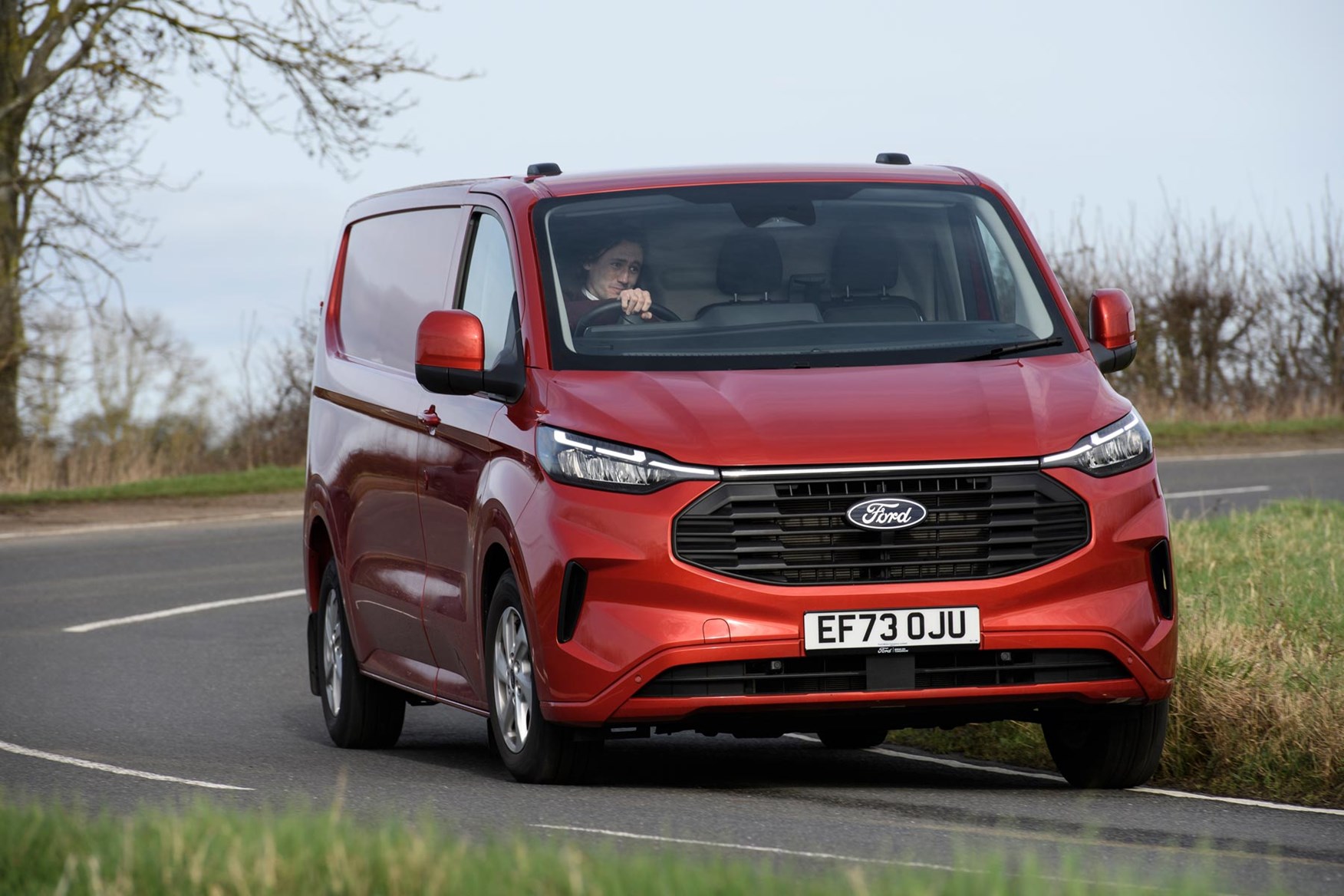
However, the solid and connected feel to the Transit Custom’s steering was one of the things that we loved about the previous generation, as it gave a real sense of where the wheels were on the road. We can’t help but be a little sad that it has been dialled back a bit.
The new Transit Custom’s ride is also excellent, as it deals with all the imperfections on (admittedly well groomed) urban and rural roads. The other caveat to this is that we have only sampled the Transit Custom with a 400kg payload in the back. This is fairly representative of the sort of work that it will be doing, but it does mean we haven’t had a chance to try it out with nothing on board or a heavier load.
So far, though, it has proved comfortable and easy to drive, which is a good thing on the whole.
What engines and gearboxes does the Ford Transit Custom come with?
The engine range is the least new element of the Ford Transit Custom, as the launch units are all ones that are carried over from the previous model. This means you get four 2.0-litre diesels to choose from, a 110hp, 136hp, 150hp or 170hp.
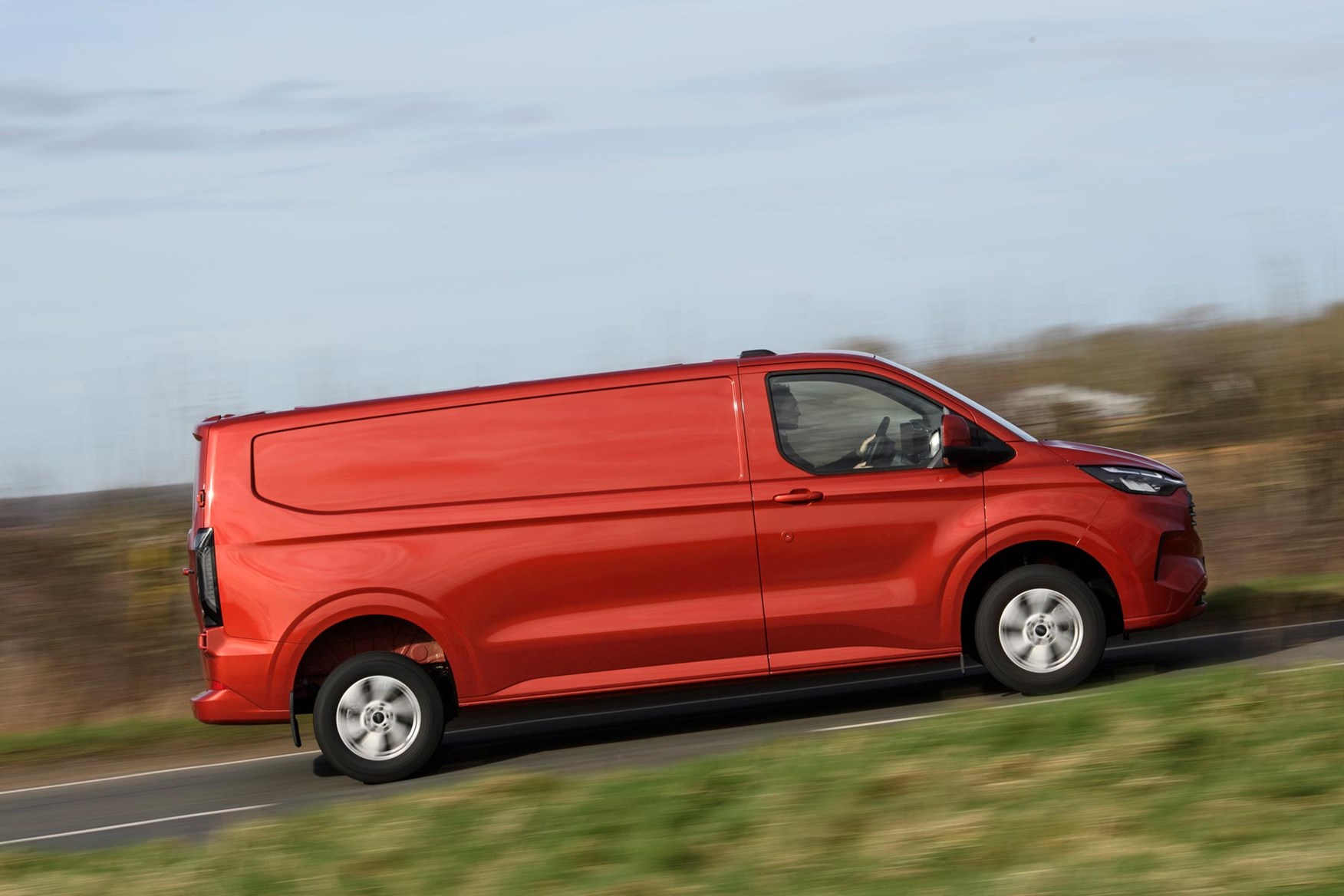
Although the engines are the same, Ford has boosted economy slightly, improving mpg by 6%. Some of this will be down to the improved aerodynamics, though.
There are two gearboxes – a six-speed manual transmission and a new eight-speed auto.
Visibility
There are no odd-shaped small windows or strangely large door mirrors on the Transit Custom, which means it is easy to see out and around. The small second mirrors on the side of the van mean you can keep an eye on your blind spots without resorting to odd setups involving mirrors on the passenger sun visor.
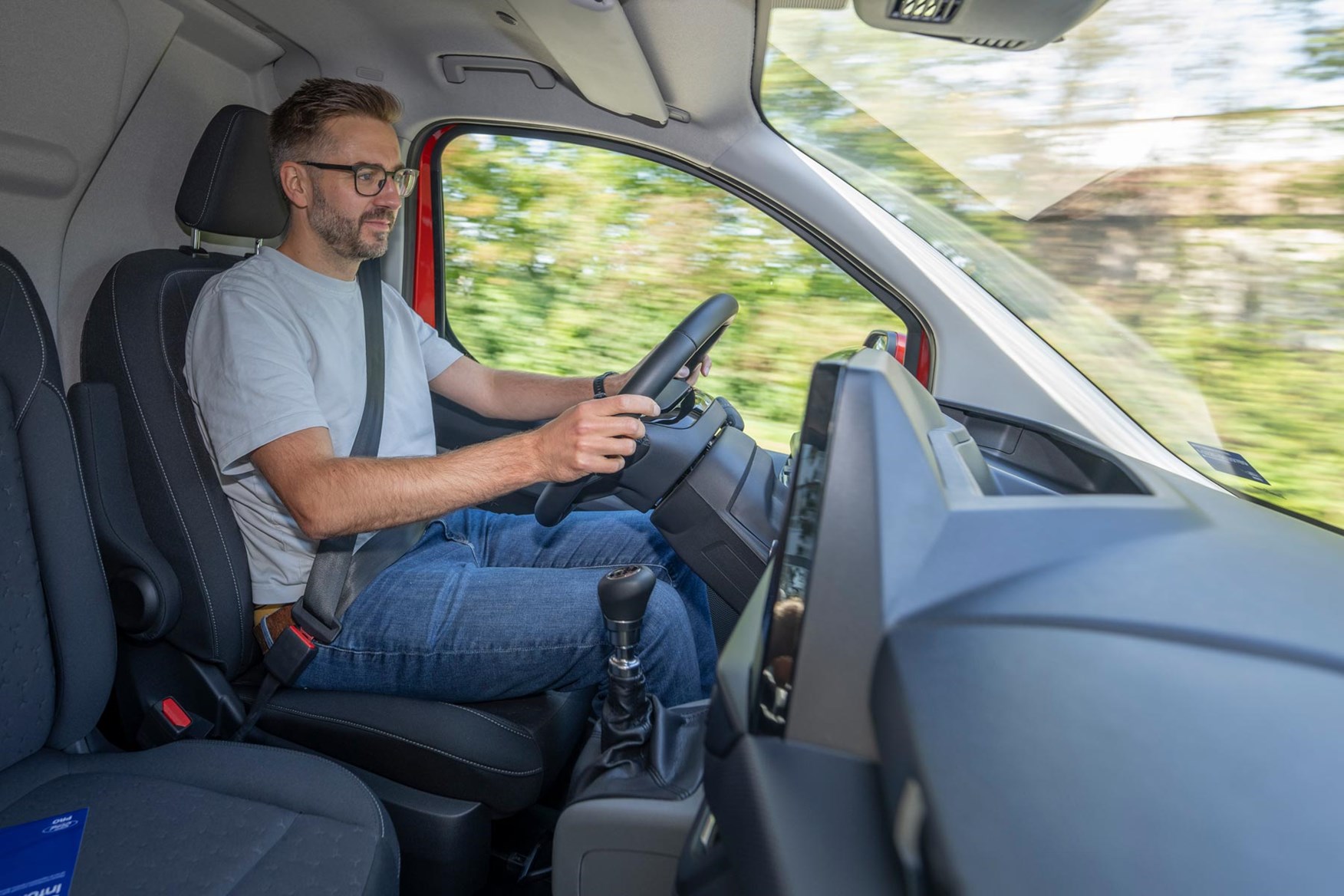
The best bit is that you get rear parking sensors on every van, even the base-level Leader. It only takes one step up to Trend to add rear parking sensors and a rear-facing camera, which is a very low point in the range for this to be included and will really benefit those who park in tight spots regularly or those who are not used to driving a commercial vehicle.
- Engine noise apparent
- Low roof makes for cramped feeling
- Some great storage regardless
The cabin is another area where the Transit Custom has been revolutionised. The flat floor is the most obvious and welcome change, but there are a few other details that are notable.
Room for three adults
The flat floor in the Transit Custom’s cab is such a welcome addition it makes you wonder why any van would offer anything different if such a thing is possible. It means that the middle passenger gets a lot more foot space, but it also turns the floor into a more useable area. Ford says it had feedback from a customer that likes to carry his pots of paint next to him in the cabin, and this was one of the driving reasons for developing the new layout.
It does mean that you will have to keep more of an eye out for loose items that could roll about on the floor. Although there is a small bit of protection around the driver's footwell, it means that there is much less that will get in the way of things ending up under the pedals.
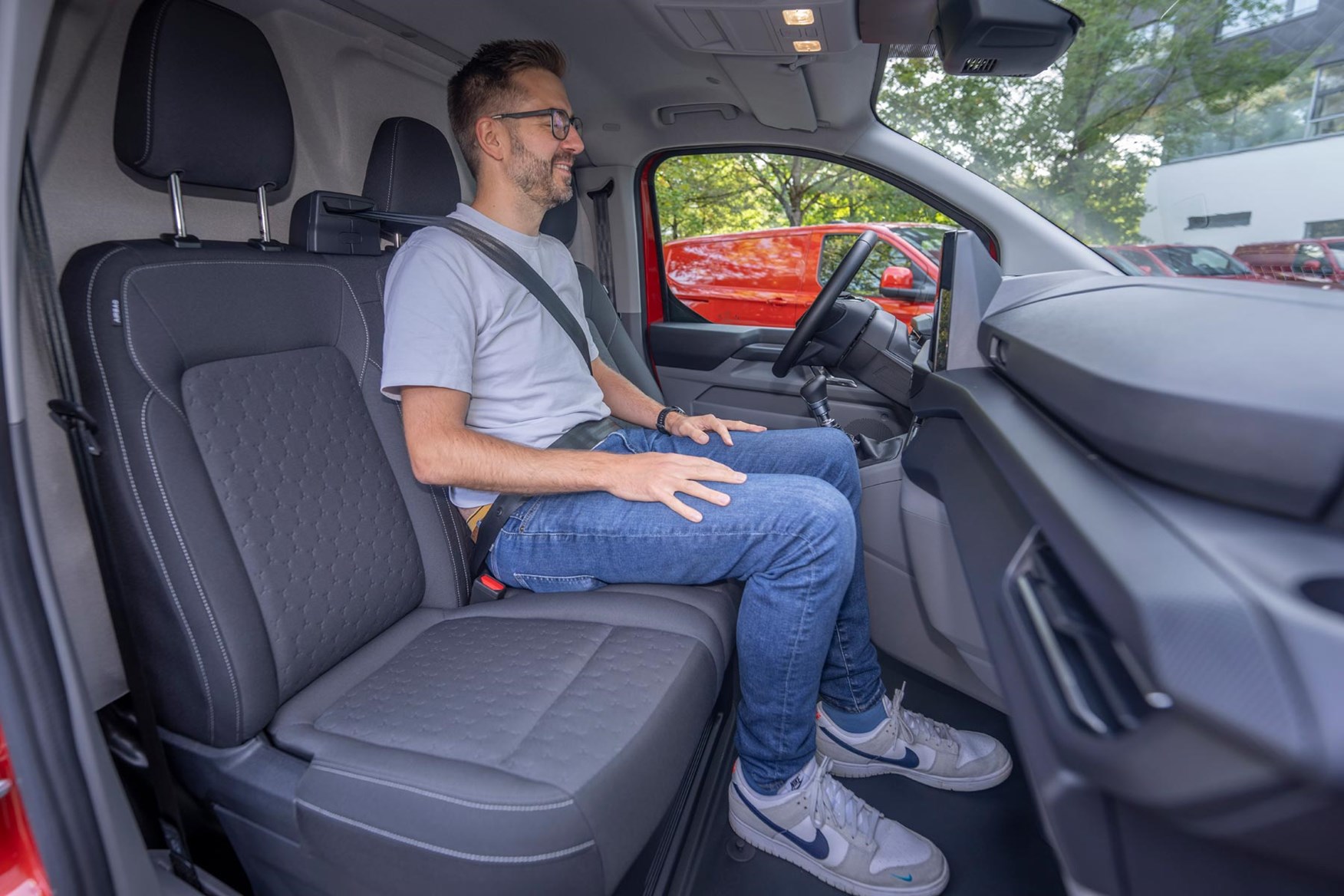
Those that want to carry three adults regularly will be better suited with the automatic version, though. Unusually, this version has a differently shaped dashboard to the manual. The manual has the gear lever jutting into the space where the passenger’s knee would go, whereas the auto has its gear shifter up by the steering wheel. Although you can still get three adults in the front of the manual without bashing shoulders, there is loads more room to get the middle occupant's legs comfortable in the auto. The middle passenger is also right by the location of the middle cupholder (handily located low down rather than up on the dash in the sunlight) and the charging ports for your phone's cable.
Mixed amounts of storage
The storage in and around the Transit Custom’s cabin is both good and varied. There is a trio of different spaces in the door, with a small one higher up just below the door handle, a larger one with a bottle holder lower down and a smaller one right at the bottom that should be largely out of sight with the door closed.
There are a couple of open spaces on the top of the dash in front of the steering wheel, while there is a pair of glove boxes. The lower one is fairly standard, not too large but big enough for a standard vehicle instruction manual.
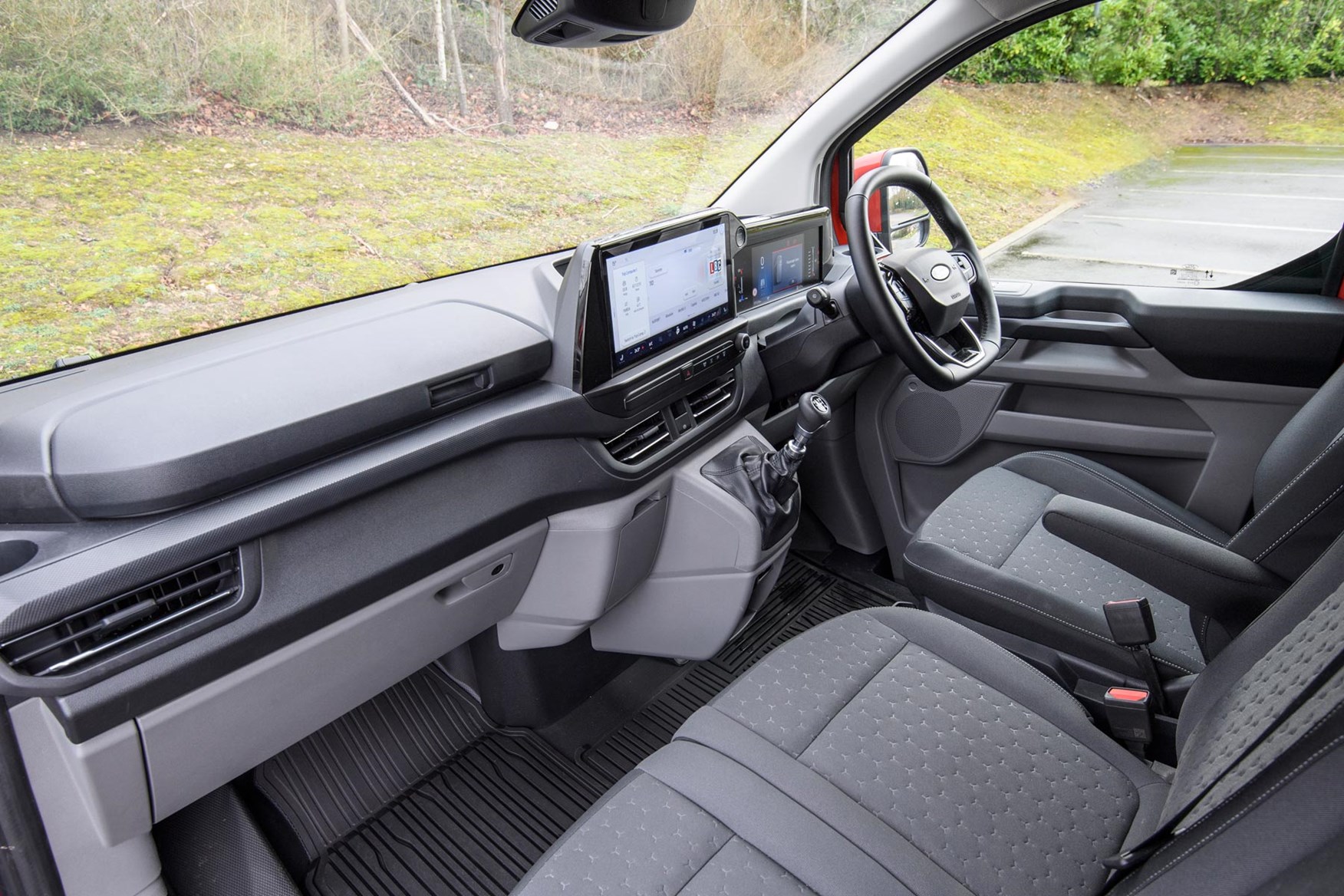
The higher one is more unusual and takes up the space vacated by the airbag, which is instead stored up in the roof. The space is therefore very deep – it goes back about 30cm or more. It’s only about 10cm high, and there is no light in there, so it is better for large, flat folders than small items that could roll to the back.
The high-up airbag means there is no overhead storage, though. The cabin roof feels a bit low as a result, making it feel a little more claustrophobic than a van sometimes does. Not overly so, it’s just another area where the Transit Custom shares more with its car counterparts. This is a criticism we also level at the Citroen/Peugeot/Fiat/Toyota/Vauxhall mid-size quintet, though, so you might well be used to a low roof if you are trading one of these in for a new Transit Custom.
There is also some handy storage under the passenger seat, which can be linked to the rear loading bay thanks to a load-through hatch.
Infotainment and screens
The screens in the Transit Custom’s cabin are another high-end feature. You get an 8.0-inch digital display in front of the wheel and a 13.0-inch touchscreen as standard. This comes with Ford’s latest Sync 4 operating system but you can also pair up your phone to use Apple Carplay or Android Auto, even on the basic Leader versions, meaning all Transit Custom drivers can have access to navigation.

It’s also got in-built Alexa functionality so you can use voice control to input destinations and the like. Again, we have yet to be able to try this out.
There are a few physical buttons, but these are more shortcuts to features such as the driving modes, driver assistance features and the window demister. The lack of physical buttons means that elements such as the heater controls are all via the touchscreen. Previous Transit Customs have had clear and easily located shortcuts to the sort of features you need regularly, so this feels like a bit of a backwards step, although it is not something unique to Ford. Our main gripe is that it means you will have to remove your gloves and really concentrate to hit the right button. A physical button is easier to prod without taking your eyes off the road.
They are at least fairly easy to find, though, and don’t require you do delve into loads of submenus.
The 13-inch screen is huge, which means you get the full widescreen effect, even when using Apple Carplay. This means you can have your Google Maps navigation on the main screen and still have a small second screen allowing you to control your music. It's a really premium feel.
High level of connectivity
Ford, naturally, has upped the connectivity stakes in the newest Transit Custom, too. There is an integrated 5G modem that allows you to access a wide range of telematics via Ford Pro. Some of these are aimed at small businesses, but Ford is also looking to take on the big aftermarket software suppliers with its own fleet management software too.
You can do all kinds of things via the Ford Pro app or Ford’s software, from locking or unlocking the van remotely, monitoring fuel economy and driving style or check the vehicle’s location.
Ford also says that you can integrate conversion controls into the new setup, so you should be able to operate third-party features through the main screen.
Not the quietest
Because the engines are not the newest, they are also not the quietest. There is a bit of a rattle and grumble from the diesel units at times, particularly when you are at a standstill. There will be quieter versions along in the future no doubt.
- Fuel economy improvement
- Improved level of standard equipment
- Wide range of trim levels
Ford has launched the Transit Custom with a strong and diverse range of trim levels, but with more to come. It has also added a fair amount more standard kit to the basic versions, which has pushed prices up slightly but has also made the van better value for money.
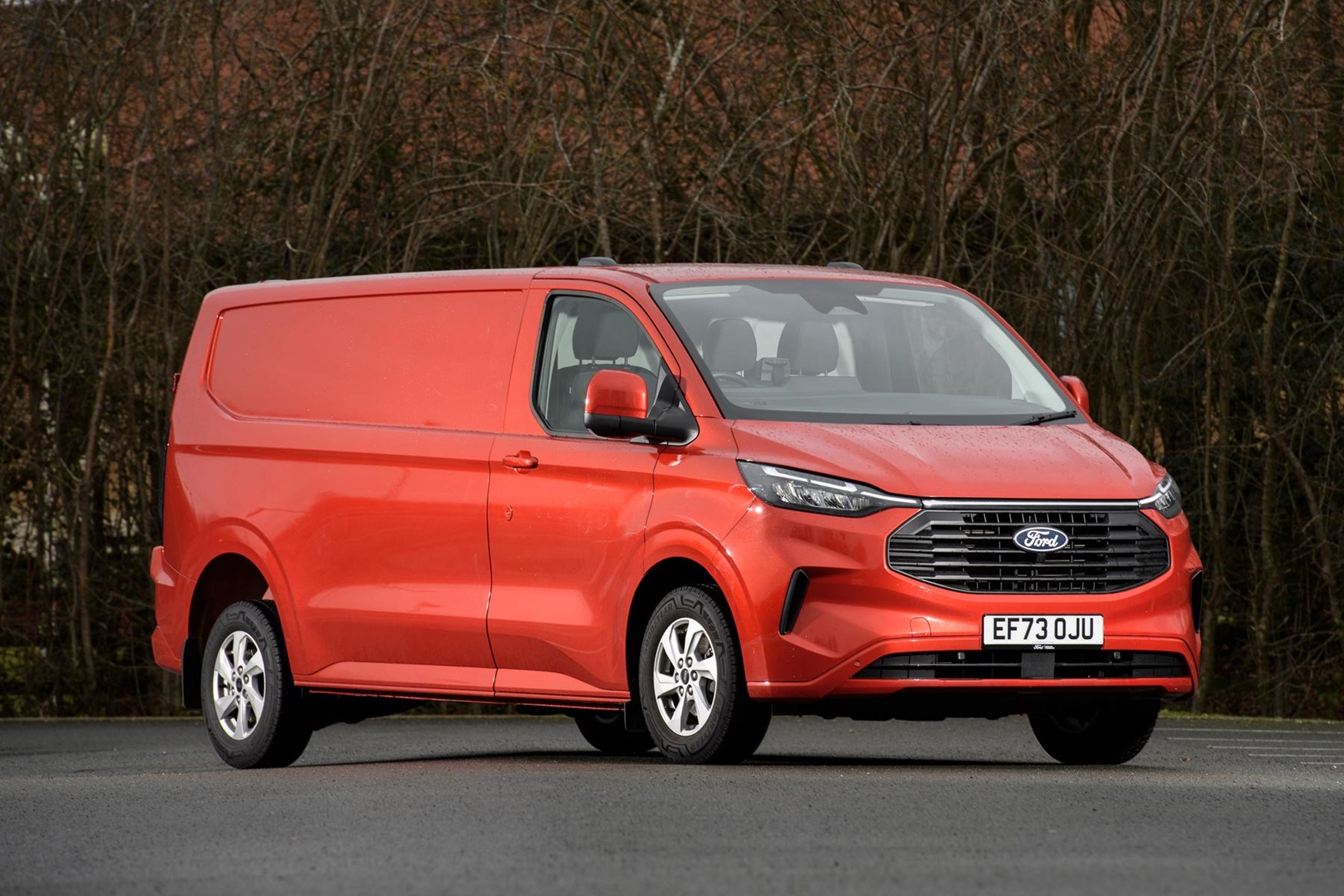
Ford Transit Custom mpg
Because Ford has carried over its engine range, fuel economy is middling at best. The previous version was not the best in the class, and the same is true for this all-new version.
Even the very best diesel van only claims just over 40mpg, with most offering an official figure in the mid to high 30s.
The outlier in the list is the plug-in-hybrid, which claims an official figure of 176.6mpg, so long as you plug it in regularly. This version won’t launch until later in 2024, though, so we have yet to sample it.
Ford Transit Custom servicing
The Ford Transit Custom needs servicing every two years or 25,000 miles, whichever comes first.
Ford Transit Custom warranty
Ford’s warranty is below many of its rivals, with only three years and 60,000 miles of cover as standard.
Ford Transit Custom standard equipment
There are five different trims to start off with in the Ford Transit Custom range, with Leader, Trend, Limited, Trail and Sport versions. There will also be another sporty model joining the range in 2024, with that expected to be an MS-RT version with upgrades that are more than just visual. Expect it to be based around the electric version, though.
Ford Transit Custom Leader equipment highlights:
- 13.0-inch touchscreen with Apple Carplay and Android Auto
- LED lights
- Full height metal bulkhead
- Manual two-way adjustable driver seat
- Dual passenger seat
- Black front bumper and unpainted rear bumper
- Black door mirrors
- Heated and powered door mirrors
- Single side sliding door
- Quick clear front windscreen
- 5G onboard modem
- Keyless start
Ford Transit Custom Trend equipment highlights (above Leader):
- Partial body colour front and rear bumper
- Air conditioning
- Locking glove box
- Heat pump (electric version only)
- Front parking sensors
- Rear parking camera
Ford Transit Custom Limited equipment highlights (above Trend):
- Body coloured front and rear bumper
- LED headlights
- Load compartment lights
- Heated front seats
- Driver arm rests and lumbar support
- Moulded floor load bay liner
- 16-inch alloy wheels
- Keyless entry and start
Ford Transit Custom Trail equipment highlights (above Limited):
- Front and rear mud flaps
- Bespoke 16-inch alloy wheels
Ford Transit Custom Sport equipment highlights (above Limited):
- LED rear lights
- Bonnet stripes
- Rear spoiler
- Dual zone air conditioning
- Powered front seat
- 17-inch alloy wheels
The Active trim will no longer be offered on the Transit Custom – that is now the preserve of the Tourneo Custom only.
- Tried and tested engines
- Historically some issues
- Loads of dealers to help out
The Ford Transit Custom is a brand new van, so it is hard to draw definitive reliability conclusions. However, the engines are carried over. The most recent recall was back in 2021, though, and was not related to the engine.
The sheer number of Transit Customs sold, and the hard lives they lead, mean that there might be a degree of problems encountered by owners, but on the flip side there are loads of dealers out there to help should anything happen.
- Ford aiming for high Euro NCAP score
- Double airbags as standard
- Parking aids all included
The level of safety kit in the Ford Transit Custom takes a welcome step forward for the model and the industry, with the kind of equipment at a level not seen in commercial vehicles on the whole.
Even the basic Leader gets a good amount of features, where many vans have had the bare minimum in the past. Ford has said it is targeting a high Euro NCAP score, although it hasn’t outright named what level it is aiming for. We’ll let you know what it manages as soon as it goes through testing.
Ford Transit Custom safety
The higher up the Transit Custom range you go, the more safety equipment you get, but unusually even the entry-level Leader gets a good amount. It comes with the following as standard:
- Collision mitigation system
- Intelligent speed limiter
- Cruise control
- Lane keeping aid
- Speed sign recognition
- Wrong way alert
- Reverse parking aid
Trend then adds front parking sensors and a rear-view reversing camera.
There are more systems available on the options list, too, such as cross traffic assist, reverse brake assist, a 360-degree camera for the first time on a van, and intelligent adaptive cruise control with stop and go.
Ford Transit Custom security
For all the standard safety features, it is a bit of a disappointment that you have to go up to the Limited trim to get an alarm included. This has been upgraded for the new 2024 model, though, so that it now covers the loading bay.
Which Ford Transit Custom is best for me?
At this stage we have only driven the 150hp 2.0-litre diesel Transit Custom in Limited trim. Going by the equipment, this is the version we would go for right now, although there are some really compelling versions on the way.
The electric, plug-in hybrid, high-roof, Multicab and all-wheel drive versions will all be along within a year, so if a standard L1H1 doesn’t suit your needs then there won’t be long to wait.




